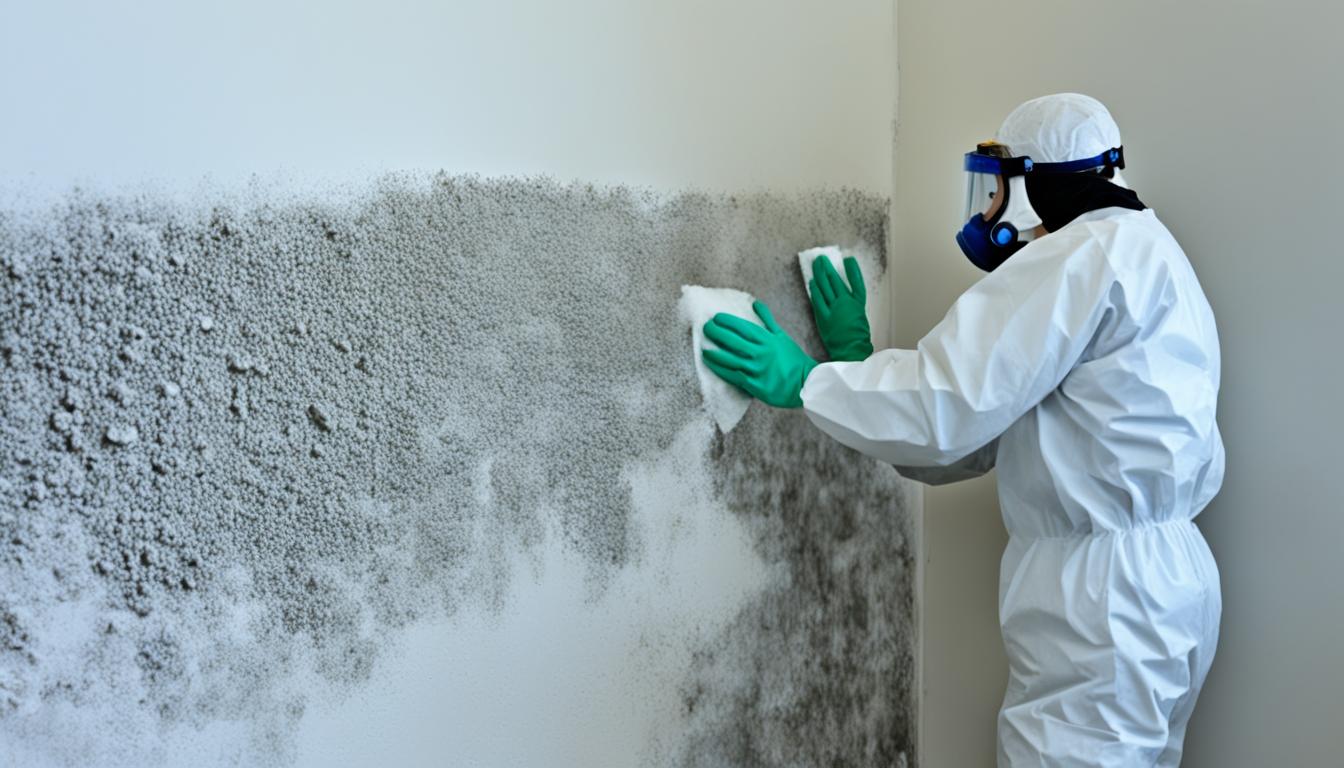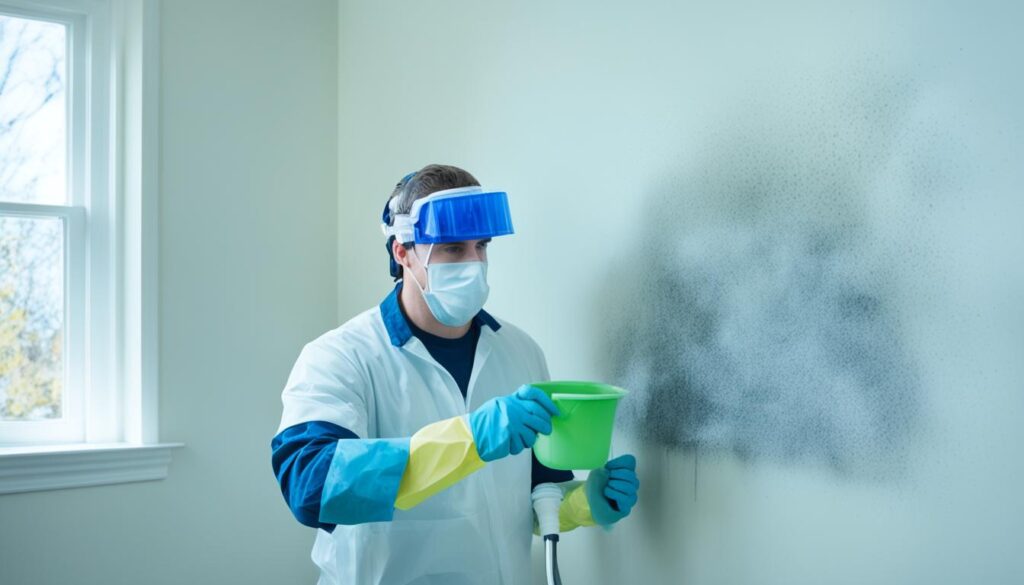
Mold Remediation Guide: How to Repair Mold Safely
Welcome to our comprehensive mold remediation guide, where we will provide expert advice on safely repairing mold. Whether you’re dealing with a small mold problem or extensive damage, understanding the right techniques and methods for mold removal is crucial. In this section, we will explore effective mold repair methods, mold restoration guidelines, and mold treatment solutions to ensure a thorough and successful repair process for your property.
Key Takeaways:
- Effective mold repair methods are essential for ensuring a safe and healthy environment.
- Following mold restoration guidelines can help prevent further damage and future mold growth.
- Utilizing appropriate mold treatment solutions is crucial for eliminating mold completely.
- Professional assistance may be necessary for extensive mold damage or persistent mold issues.
- Regular mold assessments can help identify and address mold-related issues promptly.
Understanding Mold and Its Effects
Before embarking on the journey of DIY mold repair, it is imperative to have a comprehensive understanding of mold and its effects. Mold, a type of fungi, can thrive in our homes and properties under certain conditions, causing a range of issues ranging from structural damage to health hazards. To ensure effective mold mitigation and repair, it is crucial to be equipped with the right knowledge and techniques.
One of the key aspects of mold repair is understanding how mold can affect your health and the well-being of your loved ones. Exposure to mold can lead to various respiratory problems, allergies, and even more severe health issues in some individuals. By addressing mold-related issues promptly and using proper repair methods, you can mitigate these health risks and create a safe living environment.
To prevent further damage and ensure a successful repair process, it is essential to follow mold mitigation tips. These tips focus on identifying the source of moisture that promotes mold growth, eliminating excess moisture, and implementing effective preventive measures. With proper mold mitigation, you can curtail the growth of mold and prevent recurring issues in the future.
Now, let’s delve into the world of DIY mold repair methods. By learning how to identify and address mold-related issues on your own, you can save time and money while maintaining a mold-free environment. Throughout this guide, we will provide insights, techniques, and step-by-step instructions for successful DIY mold repair.
DIY mold repair empowers homeowners and property owners to take control of their living spaces. With the right knowledge and equipment, you can effectively address mold issues and restore your property to its former glory.

As we proceed with this guide, we will cover various aspects of mold repair, including the identification of different types of mold, effective cleaning methods, and the importance of proper ventilation in preventing future mold growth. Stay tuned for valuable insights, practical tips, and an actionable plan to combat mold-related challenges.
Steps for Mold Remediation and Repair
Mold remediation is a critical process that requires careful attention and proper techniques. By following these step-by-step mold remediation steps, you can effectively eliminate mold and restore your property to a safe and mold-free environment.
- Assess the Extent of Mold Damage: Begin by thoroughly inspecting your property to determine the areas affected by mold. Look for visible signs such as discoloration, musty smell, or water damage. This assessment will help you understand the scope of the problem and plan the necessary repairs.
- Contain the Mold: To prevent the spread of mold spores, isolate the affected areas. Close off the contaminated space by sealing doors, windows, and any other openings. Use plastic sheeting to create barriers and ensure proper ventilation to minimize exposure during the removal process.
- Wear Protective Gear: Before starting the mold removal process, ensure your safety by wearing appropriate protective gear. This includes gloves, goggles, and a respirator or mask to prevent inhalation of mold spores.
- Remove Affected Materials: Carefully remove any materials or items that have been extensively damaged by mold. This may include drywall, carpeting, insulation, or furniture. Seal them in plastic bags before carrying them out of the property to avoid spreading mold spores.
- Clean and Disinfect: Thoroughly clean all surfaces in the affected areas using a mold-specific cleaner or a mixture of water and detergent. Scrub any visible mold growth, ensuring you reach into crevices and hard-to-reach areas. Once cleaned, disinfect the surfaces using a solution of water and bleach or a commercial disinfectant approved for mold remediation.
- Dry the Area: After cleaning and disinfecting, ensure the affected areas are thoroughly dried. Use dehumidifiers, fans, or open windows to increase air circulation and reduce humidity. Proper drying prevents mold regrowth.
- Repair and Replace: Once the affected areas are dry, repair or replace the damaged materials. This may involve patching walls, replacing drywall, or restoring flooring. It’s essential to address the root cause of the moisture issue to prevent future mold growth.
- Monitor and Prevent: Regularly monitor your property for any signs of recurring mold growth. Fix water leaks promptly, maintain proper ventilation, and manage indoor humidity levels to minimize the risk of future mold problems.

By following these mold remediation steps, you can effectively eliminate mold from your property and create a safe, healthy living environment. Remember, if the mold problem persists or if you prefer professional assistance, it’s always recommended to consult with certified mold remediation experts.
Conclusion
In conclusion, understanding how to repair mold safely is essential to protect your property and the health of its occupants. Mold can cause serious damage to buildings and pose health risks to individuals, so it’s crucial to address any mold issues promptly and effectively.
If you are in need of professional assistance, look no further than Fix Mold Miami. With their expertise in mold assessments, prevention, and remediation, they are the top choice in Florida for all your mold repair needs. Their team of experienced professionals is dedicated to providing comprehensive solutions and ensuring the highest quality of service.
Don’t hesitate to contact Fix Mold Miami at 305-465-6653 for a mold assessment. Their professionals will conduct a thorough evaluation of your property, identifying any mold issues and recommending the most suitable course of action. By entrusting your mold repair to Fix Mold Miami, you can rest assured that your property will be restored to a safe and mold-free environment.




